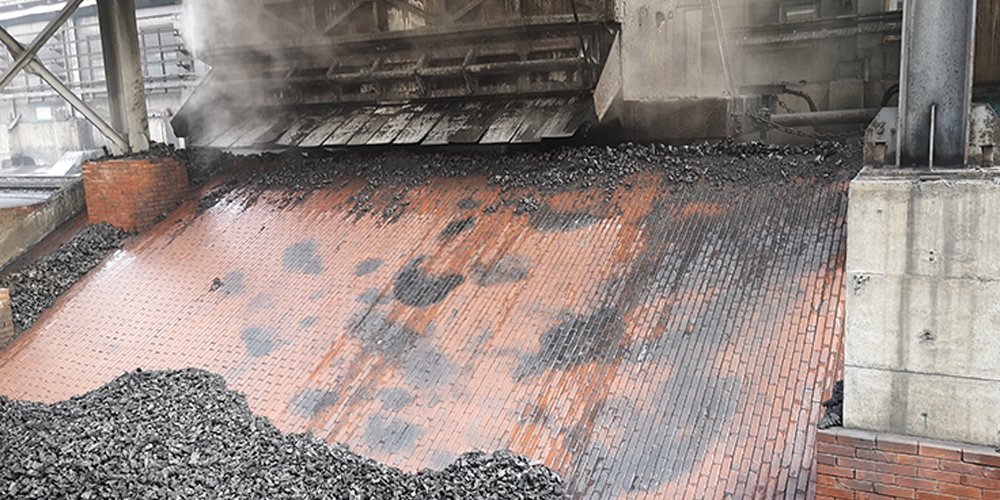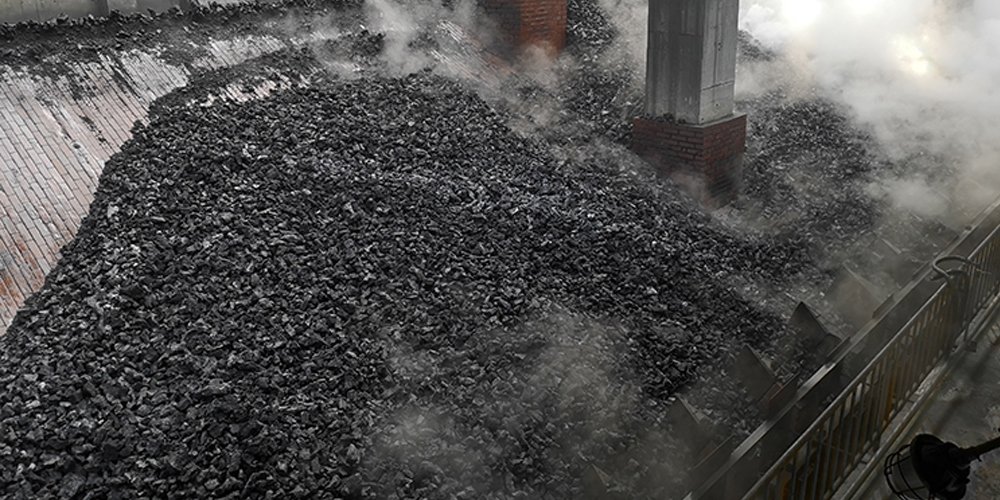Petroleum coke is a by-product when the raw oil of the delayed coking unit is cracked at high temperature to produce light oil products. It is a reusable “waste” produced in the refining process of petroleum. It is a black or dark gray hard solid petroleum product with metallic luster and porous, hydrocarbon, carbon 90-97% and hydrogen 1.5-8%. It also contains nitrogen, chlorine, sulfur and heavy metal compounds.
Petroleum coke is the pre-baked anode and anode paste used in electrolytic aluminum, carbon industry production of carbonizing agent, graphite electrode, smelting industry silicon, and is an important fuel in chemical industry, metallurgy, cement, power generation and other fields.
Classification and use of petroleum coke
1. According to the coking method:
Open furnace coke, kettle coke, delayed coke, fluid coke, the main production of delayed coke at present.
2. According to the heat treatment temperature:
Char and calcined char.
3. According to the level of sulfur content:
Low sulfur: high quality cooked coke, such as needle coke, mainly used in the manufacture of ultra-high power graphite electrodes and some special carbon products; Needle coke is an important material for developing new technology of electric furnace steelmaking in steelmaking industry.
Medium sulfur: common cooked coke, used in large quantities for aluminum smelting.
High sulfur: common coke, it is used for chemical production, such as the manufacture of calcium carbide, silicon carbide, etc., but also as a fuel for metal casting.
4. According to the different microstructure:
Sponge coke (also known as ordinary coke) and needle coke (also known as high-quality coke).
5. According to different forms:
Needle coke: with an obvious needle-like structure and fiber texture, after calcination, it is mainly used as a high-power and ultra-high-power graphite electrode in steelmaking, and some are used as negative electrode materials.
Pellet coke or ball coke: the shape is spherical, diameter 0.6-30mm, is generally produced by high sulfur, high asphaltic residue, can only be used as power generation, cement and other industrial fuels.
Sponge coke: high chemical reactivity, low impurity content, mainly used in aluminum smelting industry and carbon industry.
Powder coke: runoff coking process production, its particles in (diameter 0.1~0.4mm) volatile high thermal expansion coefficient is high, can not be directly used for electrode preparation and carbon industry.

How to choose high quality petroleum coke
The quality of petroleum coke largely depends on the nature of the raw material and its processing conditions. The main quality indicators are:
Refers to the content of sulfur and ash in petroleum coke. High sulfur coke will cause products to flatulence during graphitization, resulting in cracks in carbon products. High ash content will hinder the crystallization of the structure and affect the performance of carbon products.
Refers to the structure of coke and the size of the mesophase spheroids. The coke formed by small spheroids has a porous structure such as sponge, and the coke formed by large spheroids has a dense structure such as fiber or needle, and its quality is superior to that of sponge coke. In the quality index, true density roughly represents this performance, and high true density means good crystallinity.
3. Thermal shock resistance
It refers to the cracking resistance of coke products under the thermal shock of sudden rise to high temperature or rapid cooling from high temperature. The products of needle coke have good thermal shock resistance, so they have high use value. The coefficient of thermal expansion represents this property. The lower the coefficient of thermal expansion, the better the thermal shock resistance.
The relative content of powder coke and bulk coke (usable coke) contained in the reaction coke. Powder coke is mostly broken by mechanical action such as extrusion friction in the process of coke removal and storage, so its amount is also a manifestation of mechanical strength. The raw coke can be prevented from breaking after being calcined and matured. Coke with more granular coke and less powder coke has higher use value.
5. Petroleum Coke production methods
In the early stage, the coking process of petroleum coke production was kettle coking or open oven coking, but delayed coking is widely used at present. In addition, a small number of refineries use fluid coking, contact coking and other coking processes.
Delay coking
Delayed coking unit is the main processing unit for increasing the yield of light oil and producing petroleum coke in refinery. It converts heavy low-value oil products such as vacuum residual oil, atmospheric residual oil, viscosity reducing residual oil, heavy crude oil, heavy fuel oil and coal tar into high-value liquid and gas products through deep thermal cracking reactions, and at the same time produces petroleum coke.
In the delayed coking process, the horizontal tube heating furnace is usually used to heat the material to a reaction temperature of 490~510℃ under the condition of high flow rate and short residence time, and then enters the coke tower. Under certain temperature, residence time and pressure conditions in the coke tower, the material will crack and condenze to produce gas, gasoline, diesel oil, wax oil and coke. Due to the short residence time of the material in the heating furnace tube, only the shallow thermal cracking reaction occurs, and after the material quickly passes through the heating furnace tube and obtains the energy required for the reaction, its cracking and condensation coke reaction is “delayed” to the coke tower downstream of the heating furnace, so the process is called “delayed coking”.

The delayed coker is mainly composed of 8 parts:
Coking part – fractionation part – gas recovery desulphurization – hydraulic coke removal – coke dehydration storage and transportation – blowing air vent system – steam generation- Coke roasting
Contact coking and fluid coking
Contact coking and fluid coking: contact coking belongs to thin oil layer coking, the heat carrier of contact coking is the coke particle, the active surface of the coke particle is the center of the formation of new coke layer, according to the different size of the heat carrier coke particle, contact coking can be divided into two categories:
(1) Moving bed contact coking with large particle size (rarely used);
(2) Fluidized bed contact coking of powdered coke, referred to as fluid coking.
Fluid coking greatly improves the heating conditions of coking. The main equipment of fluid coking is a fluidized bed reactor, which is filled with high temperature coke particles (heat carrier) in a fluid state. Oil, gas and water vapor make the coke particles in a fluid state. The reaction product (oil and gas) is separated from the coke particles by the cyclone separator and enters the fractionator. In the reaction process, the coke particles are continuously drawn from the reactor into the scorcher, and some of the coke particles are burned with air, and then recycled back to the reactor to provide the heat required for the coking reaction. Excessive coke particles are discharged from the system. The liquid product yield of fluid coking is high, but the coke yield is low and most of it is powder coke. This powder petroleum coke is not suitable for making graphite electrode.
Coke oven production of calcined petroleum coke
The process method of producing calcined petroleum coke by coke oven overcomes the defects of existing calcined petroleum coke production and solves the problem that coke oven cannot produce calcined petroleum coke by delayed petroleum coke alone, and provides a process of producing calcined petroleum coke by adding asphalt to the prepared delayed petroleum coke.
The process method of producing calcined petroleum coke in coke oven consists of four systems: raw material pretreatment, coke oven dry distillation calcination, product post-treatment and gas purification.
1. Raw material treatment system, delayed petroleum coke and asphalt are pre-broken respectively, mixed with electronic belt weighers with delayed petroleum coke weight ratio of 70-99% and asphalt weight ratio of 1-30%, and then mixed and crushed, and the particle size is less than 3 mm ≥ 60%;
2. coke oven retorting system, the pre-treated raw materials, into the coke oven for high temperature retorting calcination, control the calcination temperature of 950-1350℃, coking time of 12-26 hours, mature coke cooling quenching, quenching time of 10-250 seconds, so that the coke temperature ≤100℃;
3. product post-treatment system, calcined petroleum coke after the oven, the particle size of the whole grain, crushing, screening treatment for petroleum coke (calcined char) screening, to achieve 0-150 mm particle size requirements, divided packaging or bulk shipping;
4. Gas purification system, the gas produced by high temperature dry distillation calcination enters the blast condensing system from the coke oven, and is cooled by the gas-liquid separator, condenser, primary cooling tower, blower, electric trapping tower, and final cooling tower, and the purified gas is sent out.
Customers in need can choose Qinghai Yuyuan Metallurgical Co., LTD., our company focuses on the production of metallurgical products and export trade, is a partner of many large iron and steel manufacturers, sales of ferro silicon products have been highly praised by customers!